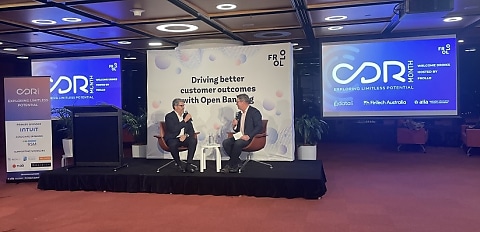The general manager of debt advice and growth initiatives at AMP Advice, Phil Quin-Conroy, has set out a vision for increasing uptake and use of the Consumer Data Right (CDR), suggesting that those who work under designated trusted advisers should also be able to access open banking data.
Speaking at a CDR Month welcome event, hosted by open banking specialist Frollo in partnership with Intuit on Tuesday evening (13 June), Mr Quin-Conroy outlined the initial findings and uptake of AMP Advice’s new open banking offering under its licensee package.
Last month, the group expanded its licensee offer to provide its advisers and the 200 brokers in its network with access to CDR data through a white label app, powered by Frollo.
The app enables AMP Advice advisers and brokers to monitor their clients’ ongoing financial position and identify opportunities to add value. This is done after the client provides consent for the adviser/broker to access their financial data under the trusted adviser regime.
According to Mr Quin-Conroy, the app has enabled advisers and brokers to undertake a more efficient ‘fact finding’ by removing the need for clients to manually provide data.
“We really liked the functionality that our advisers and brokers can roll out to their clients via the practice-branded app,” he said at the event in Sydney on Tuesday (13 June).
“So to be able to launch this money management service was really important for us because there was demand for it within our network. That’s off the back of, principally, practices who are keen to deal with wealth accumulators and help them with their budgeting and cash flow and money management. And that’s where the conversation started.
“But, very quickly, we identified that we could help them deliver some significant efficiencies in the fact-finding process and in getting access to the accurate information they need to produce financial advice or to submit a loan application. So there’s that element that we’re able to deliver into the practices in terms of saving them money through efficiencies and leveraging technology.”
However, he flagged that there were some limitations in the CDR legislation that may be holding back further efficiencies.
Mr Quin-Conroy elaborated: “What we would like is the flexibility for key staff within a practice — paraplanners, loan processors, customer service managers, practice managers — to be able to be accredited to access that data as well.
“At the minute, the way the legislation is written, it’s really the trusted adviser role (the adviser being the broker, the accountants) who are the only ones who can get access to that data. Their support staff can’t, so that’s a bit of a limitation.”
The general manager of debt advice and growth initiatives continued: “I think the introduction of the trusted adviser model has been a significant step forward with CDR. But I think this is an unintended consequence; that key players within a trusted adviser’s practice can’t get access to that data.
“I don’t think that was probably the intent. But that’s when you read the fine print … a practice manager can’t get in to see the activity across all of the advisers and brokers in their practice who are utilising the service … that doesn’t seem to make sense,” suggesting that a tweak to legislation could help further use cases.
Indeed, Frollo’s chief commercial officer, Simon Docherty, noted that “one of the major challenges of CDR is how do you enable more of that sharing where it makes sense and where it provides value back to the customer while at the same time maintaining what’s at the heart of the CDR: security, privacy and transparency.”
What’s on the CDR wish list?
While the government recently revealed that it had suspended the planned expansion of the CDR regime to more sectors in order to focus on non-bank lending and bed down the existing regime, Mr Quin-Conroy said that utilising superannuation data into the regime would further improve trusted adviser offerings.
During the discussion, Mr Quin-Conroy outlined: “I think there’s probably a couple of elements to the evolution we’d love to see. Access to super insurance data sets to feed into the CDR regime would be super important. So we’d love to see government datasets, Centrelink, ATO, those sorts of data sets feed through as well. That would be really, really handy.”
Mr Quin-Conroy also outlined that he hoped more lenders would accept CDR bank statements as approved supporting documentation for a loan application and that more APIs could be harnessed to reduce rekeying of financial information between the financial ecosystem.
“I think that’s just a natural evolution of where we’re going with open banking and we certainly want to stand shoulder to shoulder with Frollo to support that,” he concluded.
You can find out more about the open banking and CDR regime and what that means for mortgages and mortgage brokers, in this Mortgage Business Spotlight podcast, partnered by NextGen:
[Related: CDR expansion delayed to ‘allow the CDR to mature’]
